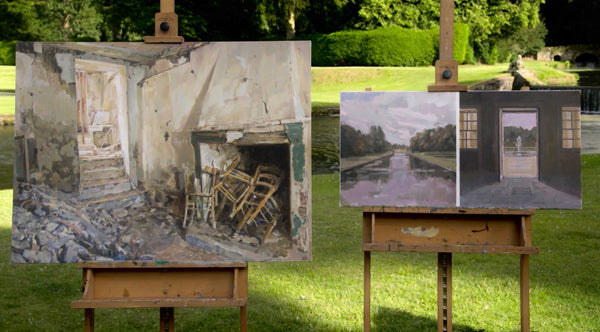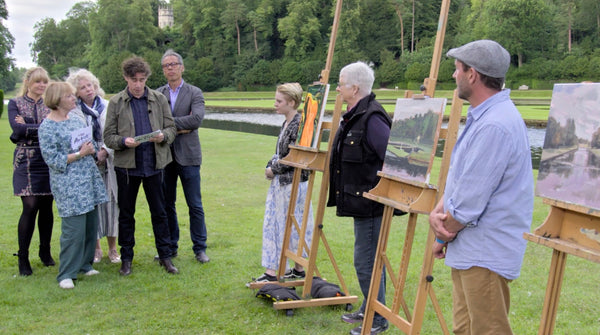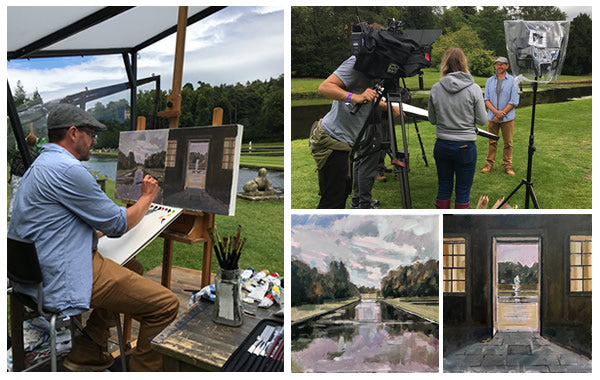Now that the programme has aired, I can reveal more about winning Sky Arts Landscape Artist of the Year 2018 Heat 4 in Yorkshire at Study Park Water Garden.
In 2017 I entered the Sky Arts Portrait Competition and was thrilled to make it through to the semi-final and paint the amazing Imelda Staunton – so the draw of applying for the Landscape show this year eventually became irresistable and I sent in my application.
How to apply
Each applicant has to submit a landscape they've done recently and although I've been busy with lots of landscapes painted in Devon and Yorkshire, it was some of the Italian earthquake paintings that had originated from a residency in Farindola that I felt summed up my view of landscape with an inherent narrative. My favourite, a large interior painting of a derelict house where now redundant chairs were piled up in the forgotten fireplace, captured everything I felt about a new kind of landscape - an internal landscape as a record of our carved out by the buildings we make and inhabit.
I'll admit it was a bit of a risk to push the boundaries of what landscape might be considered to be, but fortunately the judges saw the idea behind the piece - I got the call and I was in.
For those who'll watch the show, you probably won't realise just how much our location and view are kept secret from us right up until the day of filming. Consequently, you don't have much of a chance to prepare and strategise - you just have to respond to what is in front of you on the day.
I'd taken a selection of canvasses of different shapes and sizes to give myself a range of options - plus my normal packs of Liquitex Acrylics and Michael Harding Oils. In recent months I'd been starting paintings on top of an existing colour layer - a ground of neutral pink acrylic - and I used this method on the day to eliminate the bright white canvas dominating the painting as it developed.
Making a start
Whenever I’m painting, the resulting work is going to be the product of some key relationships and the more conscious I am as an artist of these relationships, the more interesting the work becomes for me. My submission was an internal landscape – the interior of an earthquake-damaged building in Farindola in Italy – a record of how nature impacts what is man-made. At Studley Royal, this was turned on its head as the landscape we were given was a classic example of how man had impacted nature – completely transforming it into something artificial.
I remember saying to Tai Shan Shierenberg - who asked me at the start what I thought of the view - that it had everything but it also had nothing. The pods were placed in front of a complex network of carefully engineered 18th Century water features, ponds and gardens but there was no focus, no balance of perspective, no harmony to work with – compositionally it was a real challenge.
In this kind of garden you are being manipulated by the designer to focus on an architectural feature or mock ruin, so I decided to paint a diptych with one panel showing what was in front of me and the other from a folly looking back towards the pods. I really wanted my work to go beyond just painting the view on its own, in order to say something about how I was experiencing the place, its multiple viewpoints and to extend the conversation about what plein air painting could be.
The technical process
Those who have studied with me will know that I like to establish overall tonal values in my paintings early on and that in order to do this (especially when painting en plain air) I use acrylics as they dry fast and allow me to layer oil on top within matter of minutes.
The Cass Art own brand Grey and White Synthetic brushes were perfect for this first stage as the flats allowed me to create both fine lines and to block-in at the same time. Colour-wise I was keeping to my normal earth tones - focussing mainly on Ultramarine Blue and Raw Umber. I love these two colours more than any others, as I can get both warm and cool expressions of an essentially neutral palette with a huge range of tonality by thinning with water. Once my underpainting was finished, I took a break, stepped back and assessed the composition - asking myself questions such as, 'Does the painting balance?', 'Does the composition hold me in the painting?'. If needs be, I'll make adjustments at this stage as it's easier to correct in acrylic.
Moving on to oil, I put out my standard earth palette of Michael Harding paints with the addition of a green and purple and took up my Ivory Flat Rosemary Brushes, using Liquin as a thinning and quick drying medium. This stage was all about raising the chromatic levels in the painting whilst keeping an eye on balance and the relationships between the two sides of the canvas. Although a diptych, it needed to feel like the two sides had a harmonies and reasons for being set together.
The final stage of refinement required a lot of concentration and pushing through. By this time we've all been there since 7.30 in the morning, filmed countless segments to camera, talked to judges and presenters, dealt with the crazy weather – whilst trying to paint something to be proud of. Seeing the detail in that moment was really tricky, but in the end I was happy with where I finished after 4 hours.


Semi-Final
Next stop is the semi-final... airing on Nov 27th November on Sky Arts. Tune into find out how we all get on painting at Felixstowe docks.
